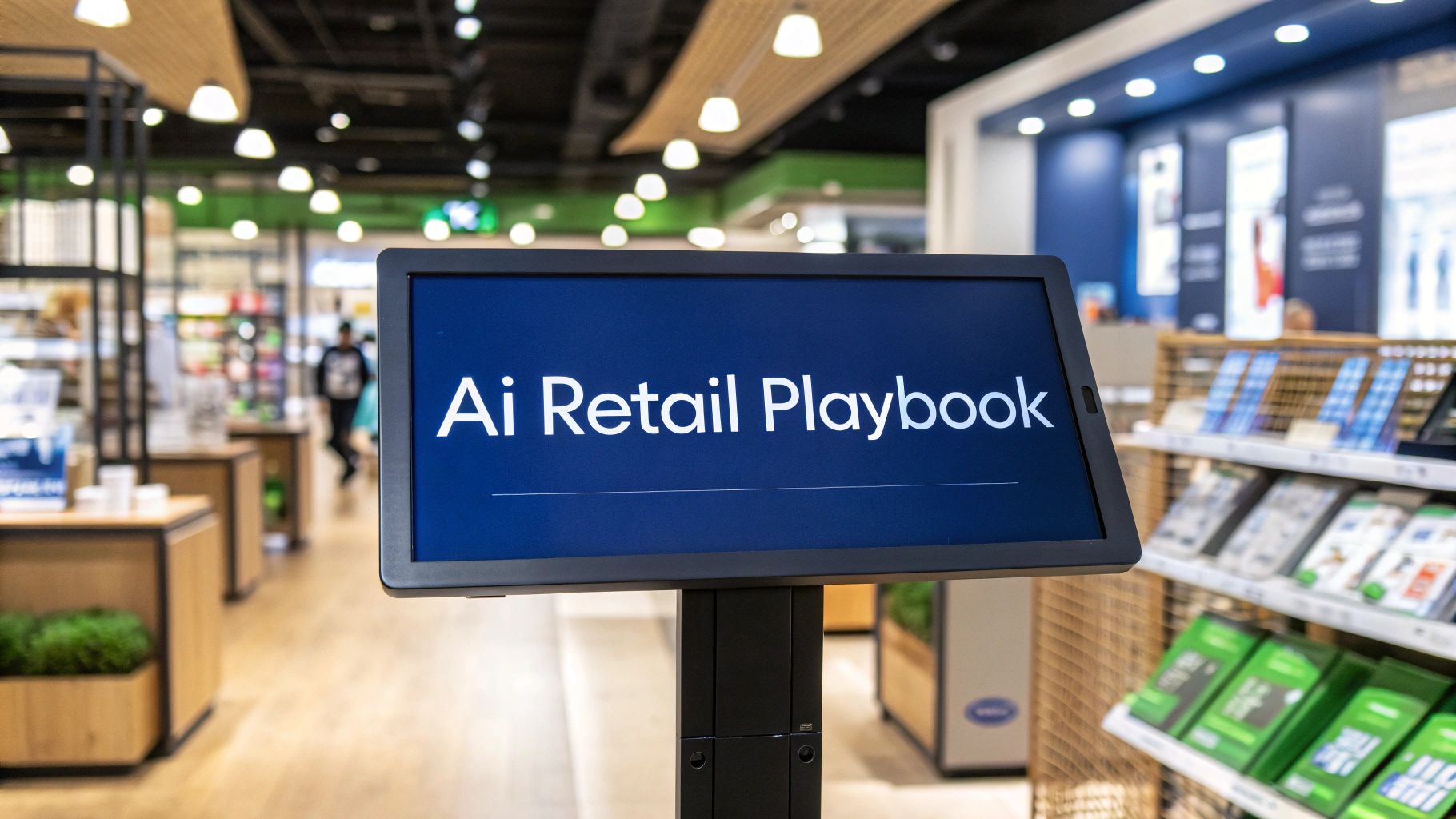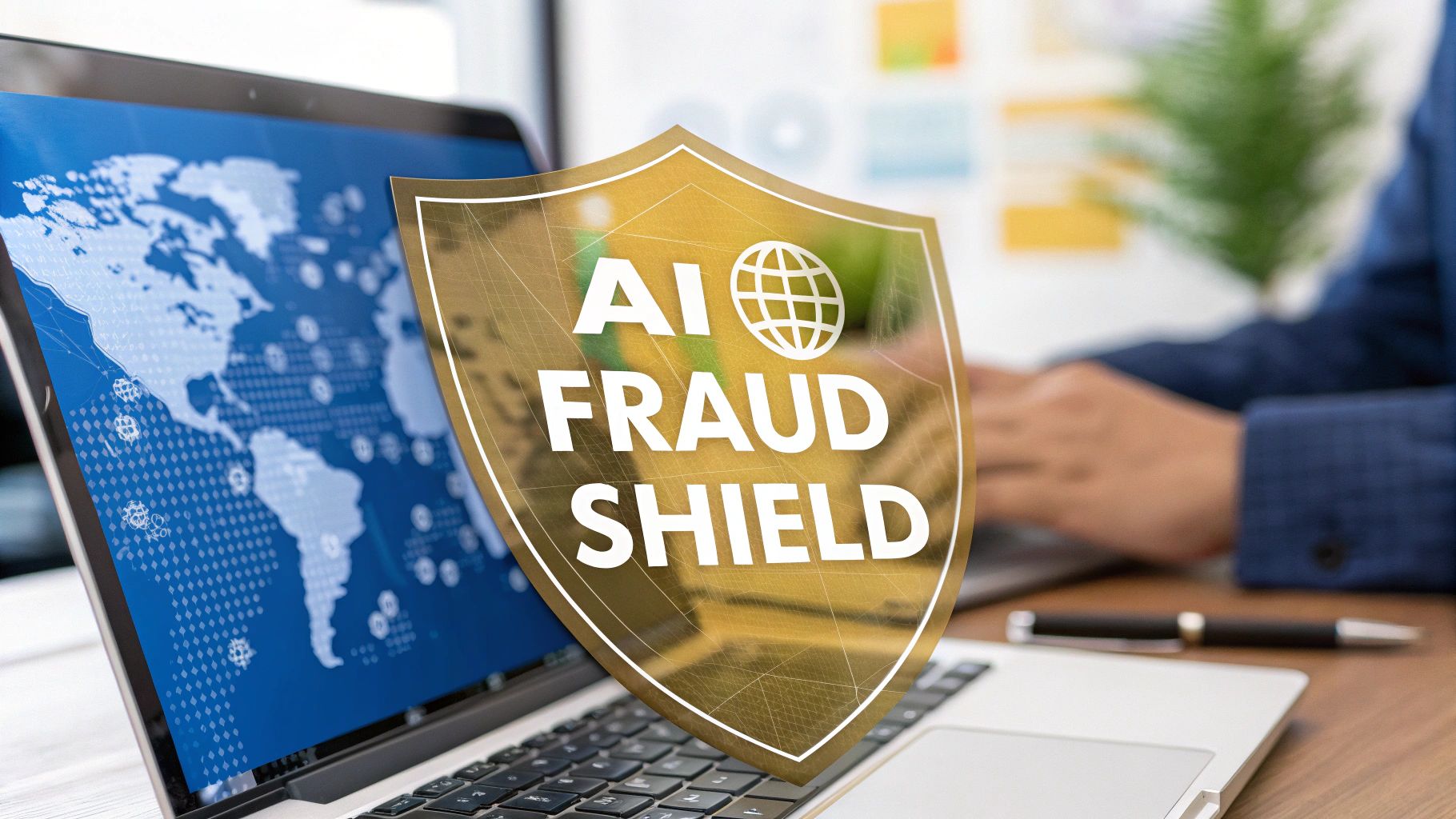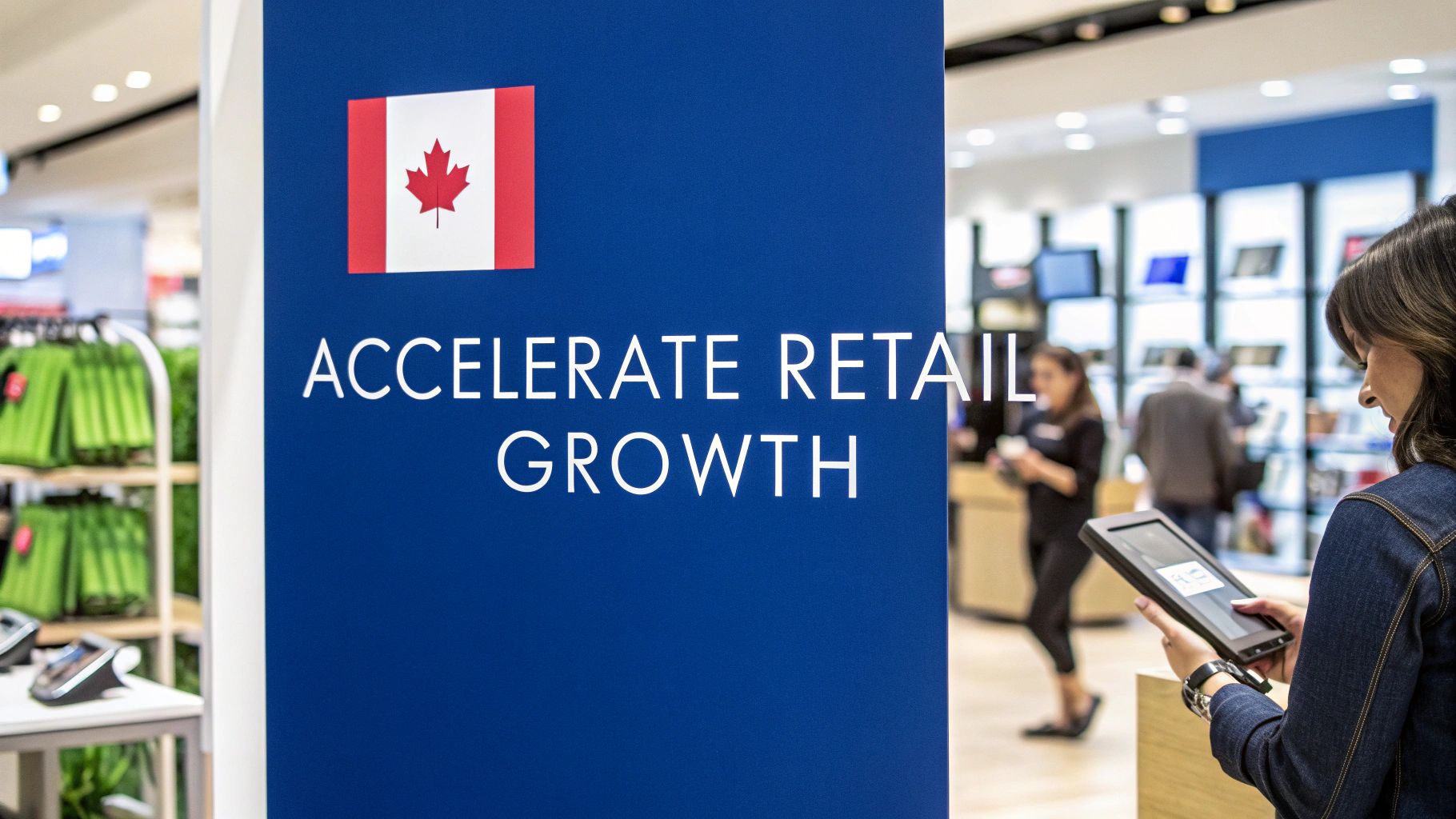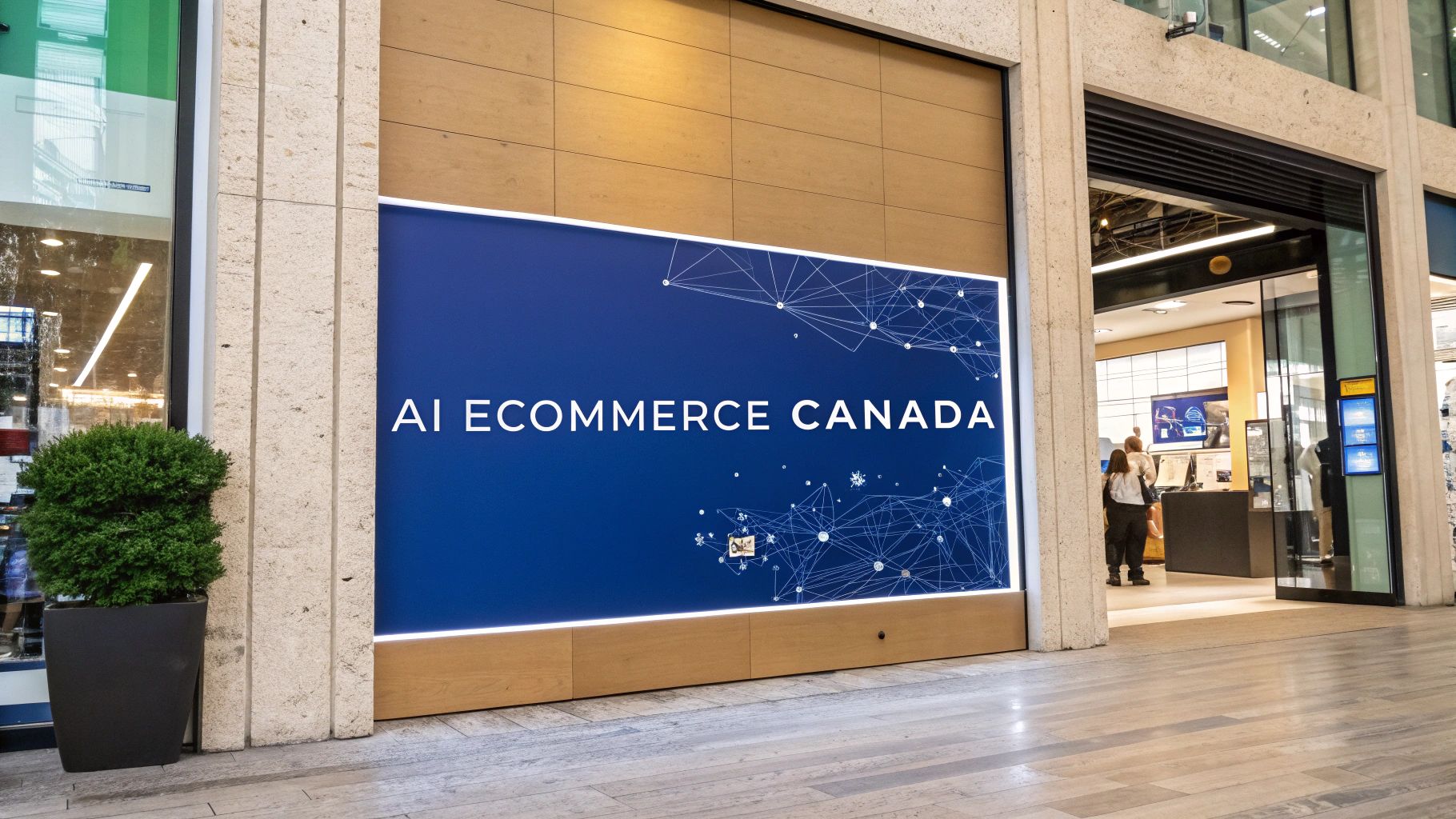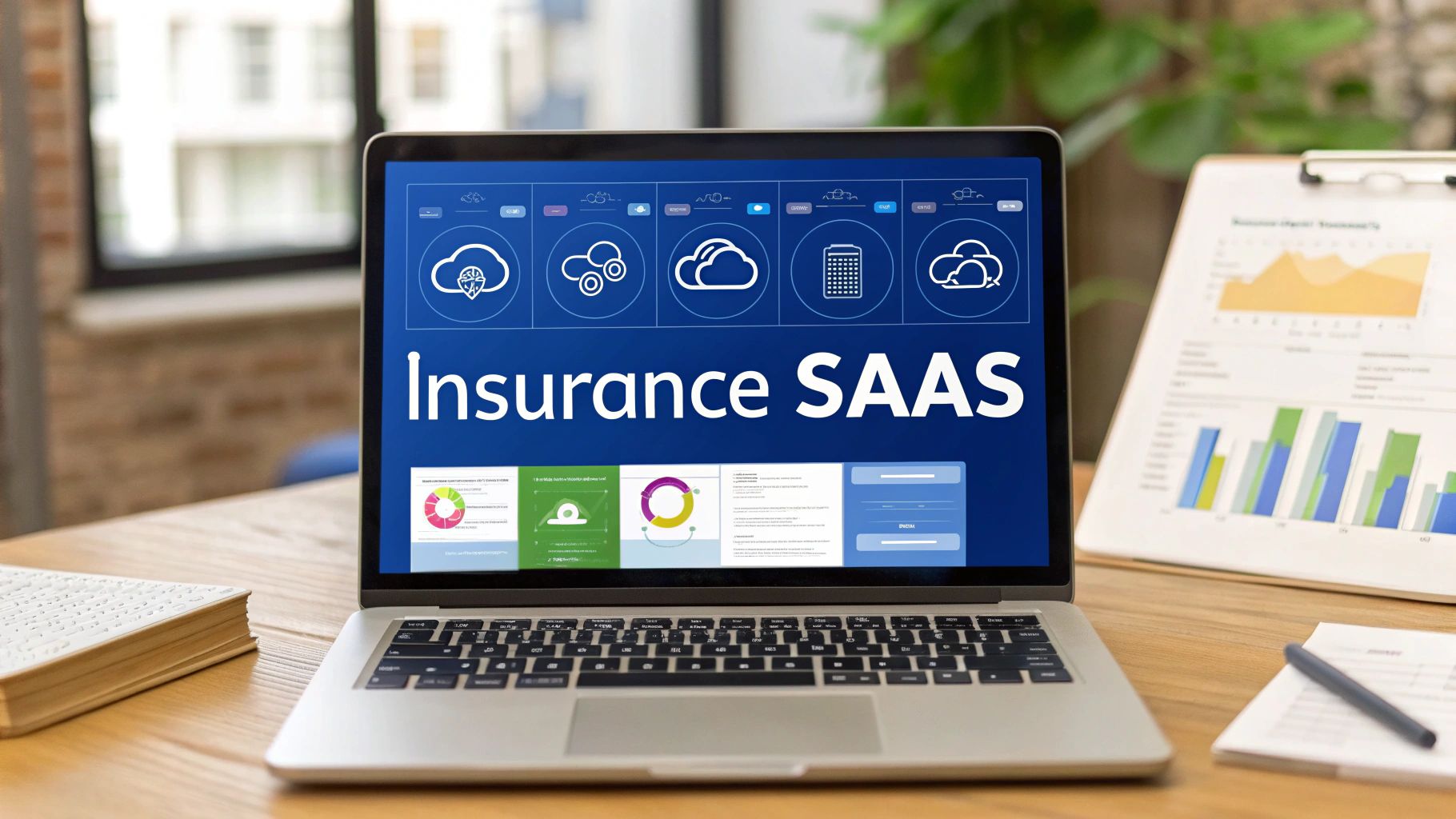When we talk about cybersecurity in insurance industry, we’re really talking about the immense task of protecting incredibly sensitive policyholder data and critical internal systems. It’s a constant balancing act between embracing new tech and defending against sophisticated digital threats like ransomware and data breaches.
The High Stakes of Digital Insurance
Think of an insurance company less like a financial institution and more like a digital treasure chest. Tucked away inside are vast amounts of highly sensitive information, such as personal details, financial records, health histories, and proprietary business data. This concentration of valuable assets makes insurers a magnet for cybercriminals.
On one hand, insurers are pushing forward with technology to stay competitive. AI-powered underwriting, slick customer portals, and IoT-driven risk assessments aren’t just buzzwords anymore; they’re vital for growth. But on the other hand, every new app, portal, or connected device adds another potential door for attackers to try to open, expanding the company’s digital footprint.
A Unique and Complex Risk Environment
What makes this so tricky for insurers is their dual role. They are not only a target for cybercrime themselves but are also the ones providing cyber insurance policies to other businesses. This puts them in a tough spot: they have to be experts at defending their own networks while also being sharp enough to accurately price the digital risks of their clients. An insurer’s own security posture directly reflects on its credibility and financial stability as an underwriter.
This dual responsibility creates enormous pressure. A single successful attack can trigger a domino effect that goes far beyond a simple data breach. The fallout can be massive:
- Crippling Financial Losses: The bill for cleanup, regulatory fines, and legal fees can easily run into the millions. Ransomware attacks in the financial services sector are consistently ranked among the most expensive cyber incidents.
- Operational Paralysis: Imagine a ransomware attack freezing your claims processing or policy administration systems. Your entire business could grind to a halt for days or even weeks.
- Erosion of Customer Trust: Insurance is built on trust. A data breach can shatter that trust in an instant, leading to a mass exodus of clients and irreparable damage to your brand’s reputation.
- Regulatory Scrutiny: With privacy laws getting tougher all the time, falling short on compliance can result in severe penalties and expensive, mandated audits.
For a modern insurance carrier, strong cybersecurity isn’t just an IT problem to solve. It’s a core pillar of the entire business strategy, directly linked to resilience, reputation, and whether the company will be around in the long run.
This guide is designed to be a clear roadmap for navigating this challenging environment. We’ll break down the specific threats insurers face, cut through the jargon of complex regulations, and lay out practical strategies to defend your organization. From building a solid security framework to using the right technology, you’ll get the insights you need to protect your digital assets and secure your future.
Understanding the Real Cyber Threats Facing Insurers Today
To get a real handle on cybersecurity in the insurance world, you have to look past the generic headlines and dive into the specific ways attackers are coming after the industry. Insurers aren’t just weathering random digital storms; they’re the targets of sophisticated, well-planned campaigns designed to hit them where it hurts: their data and their day-to-day operations.
Every threat is a direct hit to the business, causing everything from complete operational shutdowns to the slow, painful erosion of customer trust.
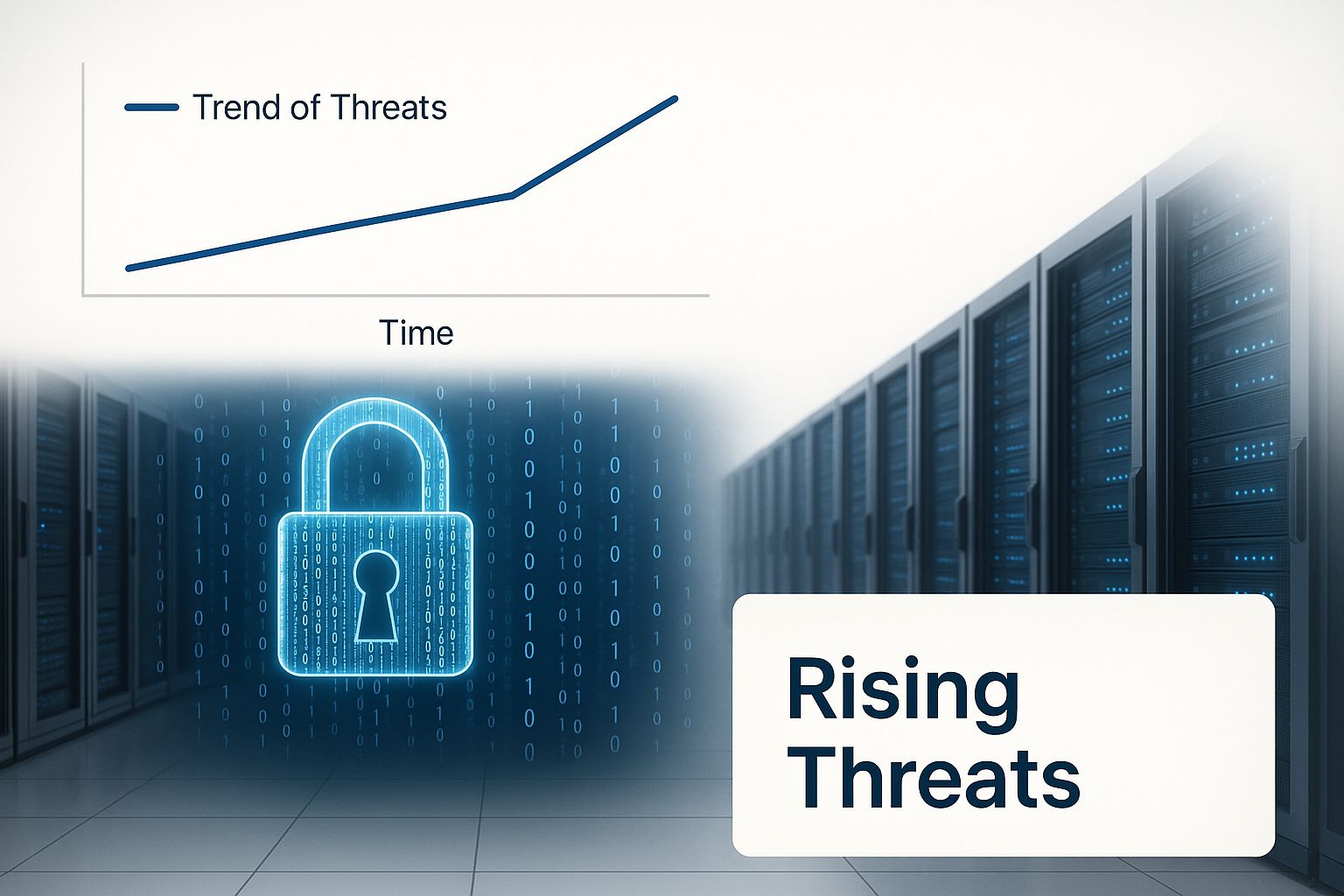
As the image above shows, the combination of interconnected systems and priceless data creates a high-stakes environment. A single weak point can trigger a domino effect with devastating consequences. Let’s break down the threats that are keeping CISOs up at night.
Common Cyber Threats in Insurance and Their Business Impact
Before we dive deeper, it helps to see the landscape at a glance. The following table outlines the most common attacks insurers face and what they actually mean for the business.
| Cyber Threat | Primary Target | Potential Business Impact |
|---|---|---|
| Ransomware | Core operational systems (claims, underwriting), data backups | Complete business interruption, significant financial loss from ransom and recovery, severe reputational damage. |
| Phishing & Credential Theft | Employees with access to sensitive data (adjusters, executives) | Data breaches, fraudulent financial transactions, network compromise, regulatory fines for data loss. |
| Supply Chain Attacks | Third-party vendors and partners with network access | Backdoor entry to insurer’s network, data exfiltration through a trusted channel, widespread operational disruption. |
| Data Breaches | Customer databases containing PII, financial, and health information | Massive regulatory penalties (GDPR, PIPEDA), loss of customer trust, class-action lawsuits, long-term brand damage. |
This table isn’t just a list of technical problems; it’s a summary of business-ending risks that need to be managed proactively.
Ransomware: More Than Just a Nuisance
Forget thinking of ransomware as a simple IT headache. It’s a full-blown assault on an insurer’s ability to do business. Picture this: your entire claims processing system is encrypted. Suddenly, you can’t process new claims, adjusters are locked out of critical files, and your main revenue stream grinds to a halt.
These attacks are getting nastier, too. Cybercriminals are now masters of double extortion. First, they steal troves of sensitive policyholder data. Then, they encrypt your systems. Now you’re facing a two-front war: pay the ransom to get your operations back online, and pay again to stop them from leaking your customers’ private information all over the internet. The operational and regulatory pressure is immense.
We’re not just talking about minor threats. Some of the most advanced ransomware, like BlackByte, showed a prevention rate of only 17% in simulated tests against financial institutions. That’s a scary number, and it proves that old-school antivirus just doesn’t cut it anymore.
Phishing and Credential Harvesting: The Human Element
Phishing attacks aimed at insurers are anything but generic. Attackers do their homework, crafting convincing emails that look like they’re from industry partners, regulatory bodies, or even the IT department down the hall. Their goal is to trick high-value targets, like underwriters or senior claims managers, into giving up their login credentials.
Once they have a legitimate login, it’s like being handed the keys to the kingdom. From inside your network, they can:
- Quietly access and copy sensitive customer files, including financial and medical histories.
- Authorize fraudulent wire transfers or bogus claims payments.
- Move deeper into the network to plant more dangerous malware for a future attack.
These tactics are constantly evolving, which is why it’s so important to stay informed. To see what’s happening right now, you can dig into this analysis of current cybersecurity trends for digital threats.
At the end of the day, these attacks work because they exploit people, not just software. That’s why regular, practical employee training is an absolutely essential line of defence.
Supply Chain and Third-Party Risks: The Backdoor Threat
Your security is only as strong as your weakest link, and that link is often a third-party vendor. A security hole in a partner’s system, whether it’s your claims processing outsourcer, a law firm, or even a marketing agency, can quickly become a backdoor into your own network.
This is what’s known as a supply chain attack, and it’s a nightmare to defend against because the threat comes from a source you’re supposed to trust. The industry is waking up to this reality. While ransomware remains the top insured threat, covered in 97% of cyber policies, and phishing is included in 89%, coverage for supply chain risks has shot up to 66%. This jump shows a growing recognition of just how vulnerable insurers are to their partners’ security flaws.
To truly appreciate the scale of these interconnected threats, looking at major historical events like the NotPetya cyberattack provides some chilling but necessary context.
Here is the rewritten section, crafted to sound like it was written by an experienced human expert.
Untangling the Knot of Cybersecurity Regulations
For any insurance company today, strong cybersecurity isn’t just a good idea, but a legal requirement. The industry is wrapped in a thick blanket of regulations, all designed to protect the mountains of sensitive customer data we handle. If you fail to comply, you’re not just risking a data breach; you’re guaranteeing hefty fines and a public relations nightmare.
Getting a handle on this regulatory maze is the first real step toward building a security strategy that’s both effective and legally sound. These aren’t gentle suggestions. They’re strict, non-negotiable rules that spell out exactly how insurers must manage, protect, and prove their data security is up to snuff. Compliance has moved from a simple checklist item to a fundamental part of the business.
Data Protection Laws Are Getting Serious
The days of vague, toothless guidelines are long gone. Modern data privacy laws are specific, they have real enforcement power, and they carry a lot of weight. Think about regulations like the California Consumer Privacy Act (CCPA). It completely changed the game for data protection, directly affecting how every insurance carrier handles its policyholders’ information.
And these laws never sit still; they’re constantly being updated and made even tougher. Just look at what’s happening in California. The California Privacy Protection Agency recently kicked off a formal process to tighten its CCPA regulations. On November 8, 2024, it rolled out new rules requiring cybersecurity audits and risk assessments, specifically aimed at high-risk businesses like ours.
These proposals, which were tweaked as recently as May 2025, demand that we conduct annual, independent audits to prove we’re protecting consumer data. It’s well worth your time to explore the full scope of these updated requirements to understand what they truly mean for insurers and to get ahead of the deadlines.
This isn’t just a California thing, either. Across Canada and the rest of North America, regulators are putting the pressure on. They want organizations to prove they’re taking cybersecurity seriously, placing the burden of proof squarely on our shoulders. We have to be ready to demonstrate compliance at all times, not just after something goes wrong.
Breaking Down the Annual Cybersecurity Audit
One of the biggest changes hitting our operations is this new requirement for an annual, independent cybersecurity audit. This is far more than a quick internal check-up. It’s a full-blown, third-party examination of your entire security framework. Picture a team of impartial experts conducting a rigorous, top-to-bottom inspection of your digital fortress.
An annual audit does two critical things. First, it gives regulators concrete proof that you’re meeting your legal duties. Second, it hands your leadership team an honest, unbiased look at your real security posture, shining a light on hidden weaknesses before a hacker finds them.
When the auditors arrive, expect them to leave no stone unturned. They’ll dig into every part of your security program, including:
- Technical Defences: They will test the strength of your firewalls, check your encryption standards, and verify that your access controls are working as they should.
- Administrative Policies: Get ready to show them your incident response plans, employee training logs, and all your data governance policies.
- Physical Security: They’ll also assess how well you’re protecting the physical servers and hardware that store your critical data.
The report from this audit isn’t just a list of friendly suggestions. It’s a formal document that often has to be sent directly to regulatory bodies. A bad result can trigger more investigations, big fines, and forced corrective actions. That’s why being prepared is absolutely non-negotiable.
Turning Compliance into a Competitive Edge
While staring down this tangled web of regulations can feel overwhelming, it’s important to shift your perspective. Don’t see compliance as just another cost of doing business; see it as a strategic advantage. When you meet these high standards, you’re doing more than just dodging penalties; you’re building a foundation of trust with your policyholders.
In an industry where trust is everything, showing a genuine, verifiable commitment to protecting data can set you apart from the competition. A clean compliance record tells your clients that you’re stable, responsible, and that you truly respect their privacy. It’s the ultimate reassurance that their most sensitive information is in good hands, which goes a long way toward building loyalty and cementing your reputation as a company they can count on.
Building Your Digital Defense Framework

Now that we’ve covered the threats and rules of the road, it’s time to build your defense. A solid cybersecurity framework for an insurance company isn’t something you can just buy off the shelf. Think of it more like designing a modern fortress, with multiple layers of protection working in concert.
Each layer is designed to safeguard your most critical assets—policyholder data and the systems that keep you running. The idea is to create concentric rings of security. If one layer gives way, another is right there to catch the intruder. This shifts your posture from simply reacting to problems to actively preventing them from happening in the first place.
Mastering the Foundational Controls
Before you can get into advanced tactics, your entire defense needs to rest on a rock-solid foundation of essential security controls. These are the absolute, non-negotiable first steps. Forget “best practices”, these are now the baseline expectation for any insurer.
Consider them the locks on your digital doors. It doesn’t matter how sophisticated your alarm system is if the front door is wide open. The most crucial of these controls is Multi-Factor Authentication (MFA).
Multi-Factor Authentication is the single most effective tool you have for stopping unauthorized access. By requiring two or more pieces of evidence to prove identity, it makes stolen passwords nearly useless to criminals.
Rolling out MFA across every critical system is a must. I’m talking about everything from employee email to your core policy administration platforms. The cyber insurance world has already adapted to this reality. By 2025, underwriting standards will have become incredibly strict, driven by the massive costs of ransomware attacks. Insurers now demand documented proof that security measures like MFA are active, and they won’t hesitate to deny coverage to businesses that can’t provide it.
Proactive Defense Through Continuous Testing
A strong framework can’t be static; it needs to be constantly prodded, tested, and improved. This is where you get proactive, finding and fixing weak spots before an attacker does. Two practices are key here:
- Vulnerability Scanning: This is your routine security patrol. Automated tools regularly scan your networks, systems, and applications, looking for known security holes, the digital equivalent of checking for unlocked doors and windows.
- Penetration Testing: This is a more hands-on, focused exercise. You hire ethical hackers to simulate a real-world attack on your systems. Their job is to break in and then tell you exactly how they did it, giving you an invaluable, real-world view of your security posture.
Together, these practices create a feedback loop that helps you continuously strengthen your defenses and keep pace with emerging threats.
To help visualize how these pieces fit together, here’s a look at the core components of a practical security framework for insurers.
Core Components of an Insurance Cybersecurity Framework
| Framework Component | Core Function | Example Implementation |
|---|---|---|
| Access Control | To ensure only authorized users access sensitive data and systems. | Implementing MFA for all user accounts, enforcing the Principle of Least Privilege. |
| Network Security | To protect the integrity of the internal network from external threats. | Using firewalls, intrusion detection systems (IDS), and network segmentation. |
| Endpoint Protection | To secure individual devices (laptops, servers) where data is stored and accessed. | Deploying advanced antivirus, Endpoint Detection and Response (EDR) tools. |
| Data Encryption | To make data unreadable and unusable if it’s stolen. | Encrypting sensitive policyholder data both at rest (on servers) and in transit (over the network). |
| Incident Response | To have a clear plan for detecting, responding to, and recovering from a security breach. | Creating and regularly rehearsing an Incident Response Plan (IRP) with defined roles. |
| Security Awareness | To educate employees to recognize and report potential security threats. | Conducting ongoing phishing simulations and mandatory security training. |
This table provides a high-level roadmap, but the real strength comes from integrating these elements into a cohesive strategy that is constantly being refined.
Adopting a Zero Trust Mindset
As your organization scales, a more sophisticated philosophy is needed. This is where the Zero Trust model comes in. It’s a security concept built on a simple but powerful idea: never automatically trust anyone or anything, regardless of whether they are inside or outside your network.
The old way of thinking assumed that once you were “inside” the network perimeter, you were a trusted user. Zero Trust throws that idea out the window. It operates on the principle of “never trust, always verify.”
This means every single request to access a resource must be authenticated and authorized. Think of it like a high-security facility where you have to swipe your ID badge not just at the front door, but to enter every single room. That’s the essence of Zero Trust. While it’s a long-term strategic shift, it represents the future of robust cybersecurity in the insurance industry.
By weaving together these foundational, proactive, and advanced strategies, you create a defense that is both resilient and dynamic. For a closer look at the principles that underpin this structure, our guide to cyber security for business offers some excellent additional insights.
Leveraging Technology for Smarter Cyber Defence

Let’s be realistic: manual security processes just can’t keep pace with the sheer volume and cleverness of modern cyber threats. To build a defence that actually works, insurers are moving toward advanced technology. These tools are a force multiplier, giving security teams the power to analyze threats faster, respond more intelligently, and even get ahead of attacks before they launch.
Think of it as upgrading from a simple security camera to a full-blown intelligent surveillance system. The goal is no longer just to record what happens. It’s to proactively spot suspicious behaviour as it unfolds and kick off an automated response in real-time. This is the only way to effectively protect the massive digital footprint of a modern insurance company.
The Rise of AI and Machine Learning
Artificial Intelligence (AI) and Machine Learning (ML) are leading this charge. These systems are built to do one thing exceptionally well: sift through mountains of data. We’re talking network logs, user activity, and threat intelligence feeds, all at a speed no human team could ever hope to match. By learning what “normal” activity looks like across your network, they become incredibly adept at spotting anomalies that could signal an attack.
For example, an AI might flag a user account that normally accesses policy documents during business hours but is suddenly trying to download thousands of records at 3 a.m. That deviation from the baseline instantly triggers an alert, giving your team a chance to shut it down before a major data breach happens. Understanding AI’s role in cybersecurity isn’t just a technical exercise anymore; it’s a core business competency.
The real game-changer with AI is its predictive ability. Instead of just reacting to known threats, it can identify the faint signals of a brand-new attack, giving defenders a crucial head start.
This isn’t just theory; it has direct applications in the insurance workflow:
- Fraudulent Claims Detection: AI algorithms can scan digital claims, cross-referencing hundreds of data points to flag inconsistencies that point to potential fraud.
- Phishing Identification: These advanced systems analyze emails for subtle linguistic tells, odd links, and sender patterns that traditional filters often miss.
- Behavioural Analysis: By constantly monitoring user and system behaviour, AI establishes a baseline that makes it much easier to spot insider threats or compromised accounts.
Digging into how AI and ML strengthen cybersecurity in insurance reveals just how essential these tools have become.
Automating Response with SOAR Platforms
Spotting a threat is only half the battle. Responding quickly is what truly minimizes the damage. This is where Security Orchestration, Automation, and Response (SOAR) platforms come in. A SOAR platform acts as the central command centre, tying together all your separate security tools, like firewalls, endpoint protection, threat feeds, into one coordinated system.
When a threat is detected, the SOAR platform can automatically run a pre-defined “playbook.” This takes all the routine, time-sucking tasks off the security team’s plate, especially in those critical first moments of an incident.
How SOAR Works in Practice
Imagine an AI system detects a malicious file on an employee’s laptop. A SOAR playbook could instantly:
- Quarantine the Device: It would automatically isolate the infected laptop from the network, stopping the malware from spreading.
- Block the Source: The file’s signature and the attacker’s IP address would be added to the company firewall and web filters.
- Create a Ticket: A high-priority ticket would be opened in the IT helpdesk system, complete with all the relevant details for an analyst to begin a deeper investigation.
By automating these first critical steps, SOAR platforms free up your human experts to focus on the stuff that requires their unique skills, like threat hunting and digital forensics. This one-two punch of AI-driven detection and automated response lets insurers handle security incidents at machine speed, drastically cutting the potential fallout from an attack.
Securing the Future of Insurance
As we’ve explored the ins and outs of cybersecurity in the insurance industry, one thing has become crystal clear. Protecting digital information isn’t just an IT problem anymore; it’s a core part of the business itself, as vital as underwriting risk or managing investments. It’s what holds up everything else: operational stability, customer trust, and frankly, survival in a world that’s more connected every day.
Making real progress here isn’t just about buying new software or throwing more money at the problem. It requires a fundamental shift in thinking, where security becomes second nature to everyone in the organization, from the C-suite to the newest hire on the front lines. When every employee sees themselves as a defender of the company’s digital perimeter, security stops being a reaction to a crisis and becomes a proactive business advantage.
A Unified Strategy for Resilience
Building a truly resilient insurance firm means weaving together all the key strategies we’ve discussed. It all starts with knowing your enemy through understanding the specific threats aimed at insurers, whether it’s a sophisticated ransomware gang or a subtle attack through a third-party vendor. That knowledge has to go hand-in-hand with navigating the maze of regulations, which can be turned from a headache into a real differentiator that earns policyholder confidence.
With that foundation, you can build a defence in layers. The basics, like multi-factor authentication, are non-negotiable, while more advanced concepts like a Zero Trust architecture should be the goal. The final piece of the puzzle is bringing in modern technology. AI and automated security platforms are essential for giving your teams the ability to respond to threats at the speed and scale required today.
Proactive investment in digital security is not just about dodging a bullet. It’s about protecting the very trust that the entire insurance contract is built on and ensuring the industry remains a stable, reliable force for years to come.
In the end, the choice is pretty simple. Insurers can view cybersecurity as just another line item on the expense sheet, or they can see it for what it is: a strategic investment in their own future. Those who choose the latter path won’t just be protecting their clients and their bottom line, but they’ll be leading the entire industry into a safer, more resilient era.
Frequently Asked Questions
When it comes to cybersecurity in the insurance world, a lot of questions pop up. It’s a complex field, so let’s break down some of the most common ones to clear up the biggest challenges and smartest ways to handle them.
What Is the Single Biggest Threat to Insurers?
If you had to pick just one, it’s ransomware. Hands down, this is one of the most destructive threats out there. Its real danger isn’t just stealing data; it’s about bringing your entire operation to a grinding halt.
Imagine your claims processing systems are suddenly encrypted and completely unusable. That’s operational paralysis. The fallout is massive: huge financial losses from business interruption, eye-watering recovery costs, and potential regulatory fines if policyholder data gets out. It’s this ability to completely stop a business in its tracks that makes ransomware such a top-tier concern.
How Has Insurtech Affected Cybersecurity Risks?
The insurtech boom has been fantastic for efficiency, bringing us digital-first platforms, AI-powered underwriting, and slick mobile apps. But there’s a flip side: all this new technology has massively expanded the industry’s “attack surface.”
Think of it this way: every new app, every connection to a third-party service, and every online portal is another potential door for a cybercriminal to try to open. The sheer volume of data flowing through these interconnected systems means we need much more sophisticated security than ever before to keep it all locked down.
The core challenge of insurtech is balancing innovation with security. Each new digital service must be designed with a security-first mindset to avoid turning progress into a liability.
Why Is MFA a Prerequisite for Cyber Insurance?
It’s simple, really. Cyber insurance carriers were getting hammered with enormous claims from breaches that could have been easily prevented. They realised they couldn’t just keep paying out; they had to push their clients to adopt better security habits.
This is why foundational controls like Multi-Factor Authentication (MFA) are now non-negotiable. MFA makes it dramatically harder for attackers to get in using stolen passwords, which is one of the most common attack vectors. By making it a requirement, insurers make the risk more predictable for themselves and encourage the entire industry to be more proactive about security, rather than just cleaning up the mess after a disaster.
What Is a Cybersecurity Audit in Insurance?
Think of a cybersecurity audit as a formal, top-to-bottom inspection of an insurance company’s security setup. It’s a systematic review of all your policies, technical controls, and procedures, usually carried out by an independent expert. Regulations like the CCPA often demand them to ensure you’re properly protecting sensitive consumer data.
The auditors look at everything from your firewalls and data encryption to your employee training and incident response plans. The whole point is to give regulators, and your own leadership, an objective confirmation that you’re meeting your legal and ethical duties to keep information safe.
At Cleffex Digital Ltd, we face the unique pressures of the insurance sector. We build secure, compliant, and innovative software solutions that protect your data while driving your business forward. Discover how we can strengthen your digital defences.


